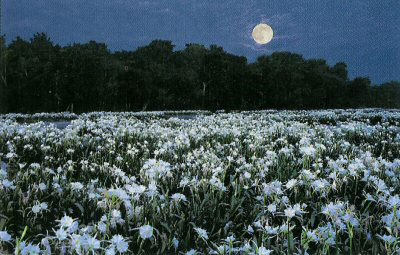Human Flower Project
Sunday, May 28, 2006
Heartthrob of the Fall Line
Along an ancient border of the American Southeast, it’s showtime for the rocky shoals spider lily.

The Fall Line
where the Appalachians drop to the coastal plain
Image: Dept. of Geography, Kokushikan University
Throughout the land of gracious drawl—the Southeastern United States—people refer to “The Fall Line,” where the Appalachian Piedmont meets the coastal Atlantic plain. “Its name arises from the occurrence of waterfalls and rapids that are the inland barriers to navigation” on all the region’s major rivers. Just as our hometown of Louisville, Kentucky, grew up on the Falls of the Ohio, where folks had to debark and tote overland, many cities of the Eastern U.S. developed along this geological dropoff, from Lowell, Mass., on the Merrimack River in the north, through Troy, NY, Wilmington, Delaware, Washington, D.C. on the Potomac, to the more southern river towns of Columbia, South Carolina; Augusta, Georgia; and Auburn, Alabama. Navigation was tough but water-power plentiful along this escarpment, a good place to unload your grain and set up a mill.
The southern stretches of the Fall Line, with warm water running over rocky shoals, proved the perfect habitat for Hymenocallis coronaria a rare and beautiful spider lily. In late May, the aquatic plant bursts into silvery flower, causing great commotion in Dixie. Landsford Canal State Park on the Catawba River in South Carolina, claiming to have the most Rocky Shoals Spider Lilies in the country, holds an annual Lily Festival, with canoe and kayak trips up river to see the flowers in bloom (sorry, y’all. It was last weekend, though surely some of the lilies are still celebrating).
In Alabama, the same plants are known as Cahaba lilies, since the Cahaba River south of Birmingham suits them. “They only occur in open well-lit rocky shoals of streams and rivers. Other requirements the lilies have are swift-moving and well-oxygenated water free of pollution and sediments.” This Alabama nature site says the flowers’ main pollinator is the “plebian sphinx moth,” a nocturnal visitor “attracted to the lily by the fragrance of the flower and the sugary reward it offers. Once seeds are produced, they drop into the water and sink to the bottom where they are wedged into rock and grow to become new plants.”
The same fragrance also attracted naturalist William Bartram, credited with first describing the rocky shoals spider lily in 1773. “After observing a population in the Savannah River near Augusta, he wrote, ‘Nothing in vegetable nature is more pleasing than the odoriferous Pancratium fluitans, which alone possesses the little rocky islets which just appear above the water.’”

Rocky Shoals Spider Lily – Full Flower Moon
Landsford Shoals, South Carolina, May 1999
Photo: Ted Borg
(Prints of this photo are for sale, proceeds benefiting conservation work in the Catawba River Valley.)
By whatever name, these beautiful flowers are disappearing. Only 50 colonies survive, yet the plant has not been placed on the federal endangered species list. Dammed creeks and sedimentation from runoff have sent too much soil to settle in the lily’s rocky and fluid habitat, so that other types of vegetation are sprouting here, crowding out the beautiful wild amaryllis. This article describes how botanical scientists are building an artificial stream to replicate the rare lily’s native habitat and study its life cycle. Clemson University’s Botanical Gardeners, given some seeds of Hymenocallis coronaria, are trying to propagate the rocky shoals spider lily and reintroduce it into shallows of the Broad River in Columbia.
Maybe rah-rah-for-rarity ecotourism and scientific research (plus endangered species status, please!) can save this beauty of the southern Fall Line.




